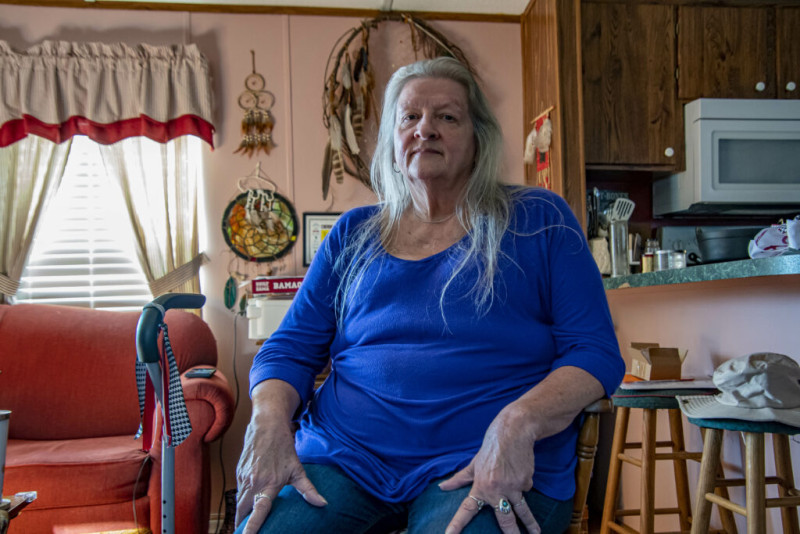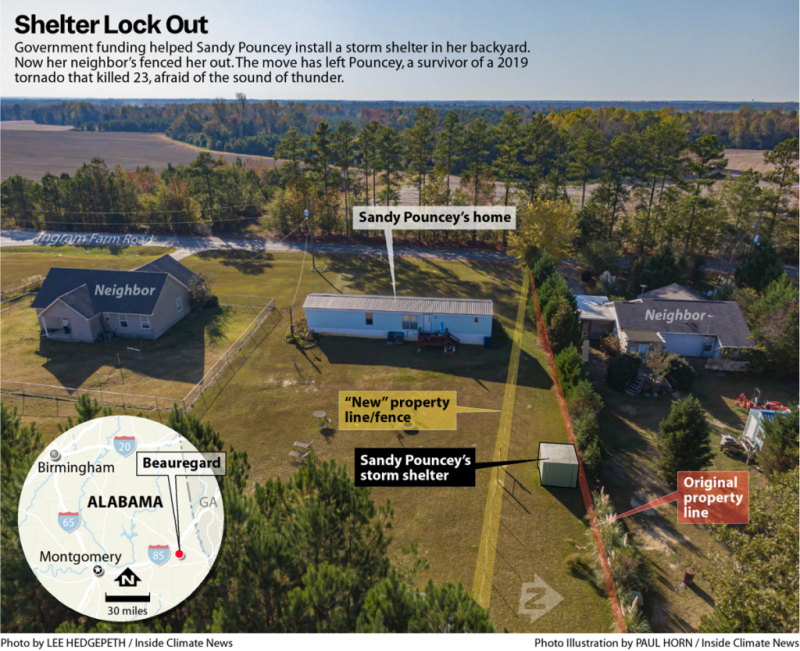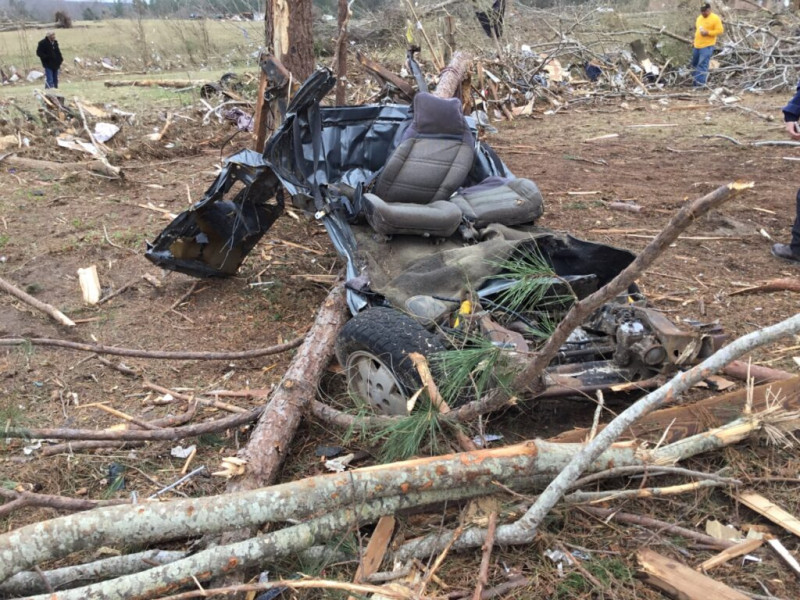Public Funding Gave This Alabama Woman Shelter From the Storm. Then Her Neighbor Fenced Her Out
BEAUREGARD, Ala.—She lay in the bathtub as her home shook around her.
Moments earlier, Sandy Pouncey had watched from her front door as a tornado began to rip through the cotton field across from her Lee County, Alabama, mobile home. Without reliable internet service, Pouncey had not known about the threat of tornadoes that day. Only when her weather radio alerted her to a tornado warning did she realize what was happening, Pouncey said. It was too late to find a more sturdy shelter. She headed for the bathroom in her home—the only room without a window—and got into the tub.
Pouncey, now 70, survived the tornado, though a patchwork of plywood still holds her home together. Many of her neighbors lost everything. Some lost their lives.
The Beauregard-Smiths Station tornado of March 2019, an EF-4, left 23 people dead and at least 90 others injured, becoming one of the deadliest in state history. The tornado’s winds scarred the landscape for nearly 70 miles through east Alabama and west Georgia, according to the National Weather Service, snapping trees, wrapping cars around them, and tossing homes from their foundations.
The tornado scarred Pouncey, too. She fears another tornado, or worse—one even stronger.
While researchers are trying to better understand the connection between tornadoes and climate change, growing evidence suggests that global warming may increase the frequency of weather conditions favorable to tornadic activity, particularly tornado outbreaks.
So in 2020, about a year after the tornado ripped across Beauregard, Pouncey was comforted when she was able to obtain and install, through public funding, an above-ground storm shelter in her backyard.
Three years later, that comfort is gone.

Early in 2023, following a neighbor’s unrelated property dispute involving grazing goats, much of the land near Pouncey’s home was professionally surveyed, showing that her storm shelter was on the edge of her neighbor’s property. In the wake of that revelation, she said, her neighbor has fenced off the storm shelter and stapled a “No Trespassing” sign on the new fence.
His actions have left Pouncey, a retiree coping with a disability, scared of the sound of thunder.
“If it starts getting overcast, I start walking the floor,” she said. “I’m real uneasy.”
Of Goats and Grazing
It started with the goats.
Pouncey said she can remember when her neighbors fenced in the land behind their property—part of another landowner’s 17 acres—for a place to let their goats roam. Before long, after a survey and a strongly worded letter on behalf of the property owner, Pouncey said, the goats and fence had disappeared.
But that’s when Pouncey’s problems started.
“He come over here and told me that part of my yard was his,” Pouncey said of her neighbor, the goat owner.
As part of their work, surveyors had marked some of the property lines adjacent to the 17-acre plot, including Pouncey’s, denoting where property lines begin and end.
Pouncey’s neighbor had come to her home to inform her that although his goats may no longer be able to graze as they had before, Pouncey’s storm shelter had actually been built on his property.
That move, Pouncey said, was anything but neighborly.
“I just shook my head,” she said.
Pouncey said she’d tried to be the best neighbor she could. When she’d moved in years ago, she’d even given them a key to her home. But not long after her neighbor informed her of the newly enforced property line, she received the key back, tucked neatly inside an envelope and placed in her mailbox.
She was shocked. Pouncey contacted a well-respected local surveyor, who charged her $350 to confirm the “new” property lines. It was a chunk of cash the retiree, who’d worked for decades in information technology at Auburn University’s College of Agriculture, said was a financial burden at an inopportune time.
The resulting survey, reviewed by Inside Climate News, showed that the diagonal property lines dictated by land deeds do not match the neighborhood’s traditionally observed property lines, forged through the decades by fencing and ficuses. Because of this confusion, Pouncey’s storm shelter had indeed been built on her neighbor’s property, outside his old fence and treeline.

At first, Pouncey said she thought the mistake was an annoyance but that it could eventually be corrected by moving the shelter the few feet necessary to place it onto her property. Soon, though, she found out the storm shelter would cost $1,800 to move—money she didn’t have. After calling around, she found a nonprofit willing to donate the time and labor to move the multi-ton structure. But it was too late.
Pouncey’s neighbor had gated the storm shelter in, erecting a haphazard fence along the newly revised, diagonal property line, just feet from the old, tree-lined fence.
“Private Property,” a sign affixed to the fence said. “No trespassing.”
A Search for Safety
Sandy Pouncey said she still thinks about laying in her tub as a tornado ripped her home apart.
One afternoon this November, Pouncey walked, cane in hand, to show her home’s scars from the storm. Not far from the bathroom where she had hidden, the plywood remained to tell the story.
“I fell trying to get back out of that tub,” she said as she pointed to the plywood and the bathroom beyond. “Over and over.”
When she was able to get on her feet, Pouncey exited the bathroom and saw the rain fall from where her roof had been, she recalled.
“It was raining in my guest room,” she said. “It was raining in my bedroom. It took my roof.”
But it was the loss of people that day, Pouncey said, that impacted her community most.
Asked about those who were lost, she said she remembers them nearly every day. Their loved ones—survivors like Pouncey—could never let her forget. She often passes them on the way to get groceries or pay the bills. She always waves, and they wave back. They’re a reminder of what has been, she said, and a reminder of what could always come again.
Pouncey said that before the storm shelter was installed, she constantly worried about the potential of another tornado. It was a feeling she believes is shared among those in Beauregard and the surrounding areas.
“After the tornado, it was horrible,” she said. “Every time it rains a little bit, I just freak out, and I’m sure I’m not the only one that freaks out. If it’s gonna be a storm, we just have a spell. That’s the only way I can explain it. It’s a spell. I can’t control it. We can’t control it.”

The reality that conditions conducive to extreme weather events, including tornado outbreaks, may be becoming more likely due to human-caused global warming only compounds her concerns, Pouncey said.
Climate scientists are worried about a connection between tornadoes and global warming, too.
While evidence attributing tornadic activity to increasing global temperatures is still developing, early research suggests climate change can impact tornados in several ways.
A 2018 study, which investigated the geographic distribution of tornadoes across the U.S., concluded that over time, the frequency of tornadoes in the Midwest and Southeast has increased while tornadic activity in other parts of the country has decreased. This shift in where tornados touch down could be caused by human-caused global warming, the authors wrote, “given the accumulating literature examining tornado/severe weather frequency and variability.”
Newer research has also begun tackling the attribution challenge head on.
Authors of a 2020 study investigated a tornado outbreak a few years earlier in the Southeast and concluded that warmer sea surface temperatures in nearby waters increased tornado frequency.

All of these dynamics, Pouncey said, keep her up at night.
“I know it’s just a matter of time before another one comes, worse than the last one,” she said. “It bothers me.”
Pouncey is among an increasing number of Americans who express worry, and sometimes anxiety, over climate change and its impacts on their everyday lives.
According to a national survey conducted in December 2022, 64 percent of Americans said they were at least somewhat worried about global warming. For some, that concern goes well beyond worry.
In the same survey, around one in 10 Americans reported experiencing symptoms of anxiety because of global warming for several or more days over two weeks. Rates of depression symptoms because of global warming were similar.
Climate anxiety, sometimes called eco-anxiety, has only recently been studied in depth by researchers, but it’s important to remember that having anxiety over global warming and its impacts is not irrational or something that’s just “in your head,” according to Anthony Leiserowitz, director of the Yale Program on Climate Change Communication, which helped conduct the survey.
“I think we are looking at people feeling worried about a real threat to human existence,” he said. “Anecdotally, I have heard from clinicians who have clients presenting in their offices talking about their anxieties related to climate change, and clinicians not really being sure what to do about it. It’s not something that’s in the person’s head.”
Left Out in the Storm
It was only when the storm shelter was installed, Pouncey said, that she began to feel some relief. She was also able to invite other neighbors without shelters to take advantage of the structure, paid for primarily through locally administered federal “safe room” funding.
“There’s a young girl with two little kids down the block, and they come every time there’s a storm and sit with me until it’s all clear,” she said. “It’s like a community shelter. That’s country living.”
Now, access to Pouncey’s shelter—for her and for others—is completely cut off.
Pouncey said her communications with the neighbor have been unproductive, often devolving into yelling.
“And I’m not like that,” Pouncey said.
Pouncey’s neighbors did not respond to multiple requests for comment from Inside Climate News.
The situation has left her with few options and a fear of the thunder. Pouncey said she was raised to believe that people are stewards of the earth, not property owners meant to stake their claims. Her interactions with her neighbor have deepened that view.
“I know I bought and paid for this piece of land, but I’m really just a caretaker,” Pouncey said. “You won’t see any ‘no trespassing’ signs in my yard.”
Pouncey said she’s only interested in one thing—having a storm shelter available for her and her neighbors to stay safe somewhere close to home. And her next-door neighbor, she said, can always join them.
“He’s welcome anytime,” she said.
Share this article
Disclaimer: The copyright of this article belongs to the original author. Reposting this article is solely for the purpose of information dissemination and does not constitute any investment advice. If there is any infringement, please contact us immediately. We will make corrections or deletions as necessary. Thank you.







